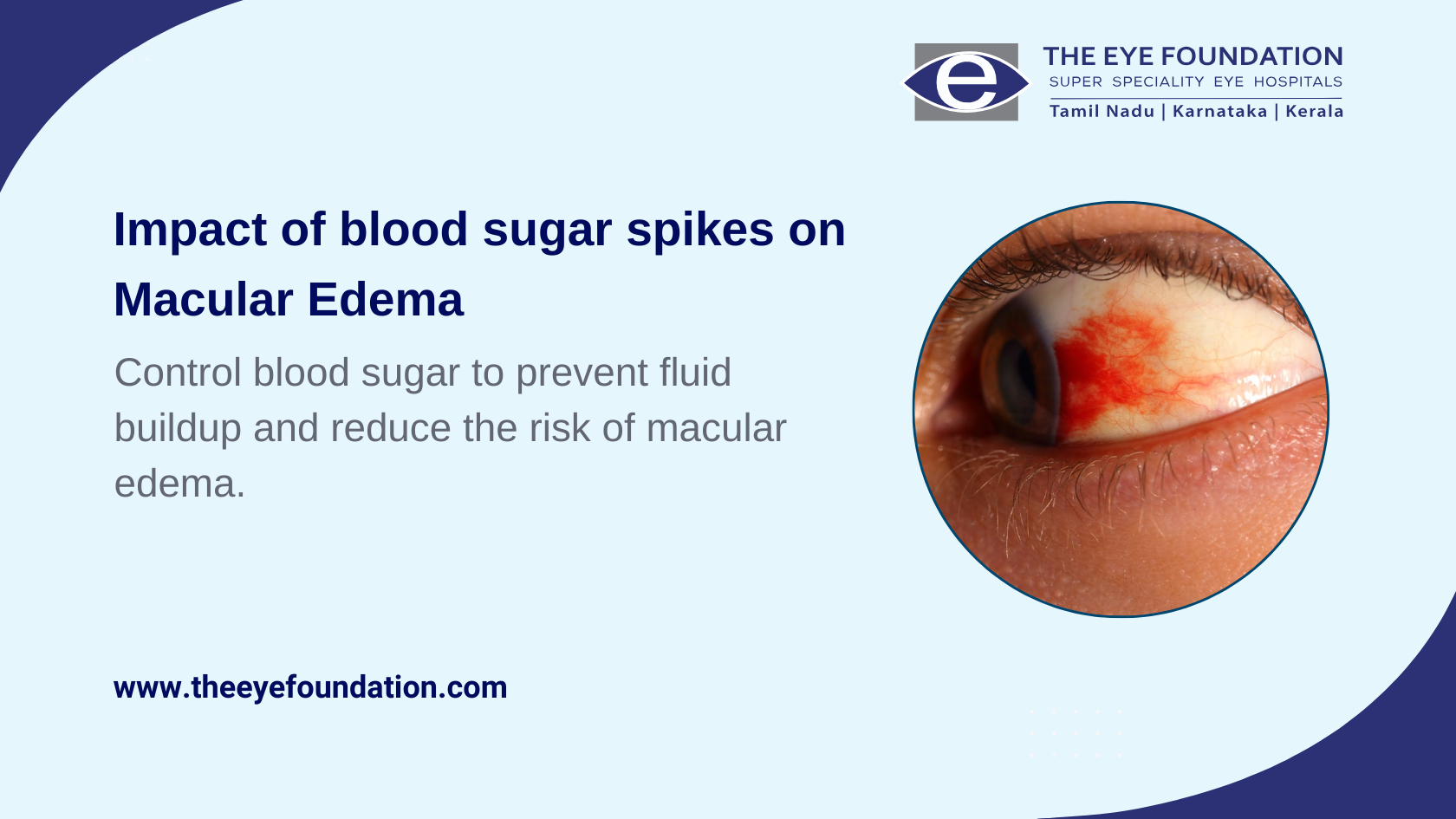For anyone with diabetes or those who are worried about their eyes, it’s important to know how high blood sugar levels can contribute to macular edema. Macular edema is a dangerous condition that affects vision and is closely linked to changes in blood sugar levels. In this article, you will learn what macular edema is, how high blood sugar affects it, and how to control your blood sugar level for the overall health of your eyes.
Understanding Macular Edema
Macular oedema is a condition whereby the macula, the central area of the retina which is responsible for high resolution vision, becomes swollen. The macula thickens and can cause a change in the clearness of your central vision, which makes it hard to read or identify people.
Macular edema can be caused by several factors, but the most frequent root is diabetic retinopathy – a complication of diabetes. Diabetic retinopathy affects the retina blood vessels and creates macular edema due to the leakage of the fluid. If the damage is not treated, it can progress to the point that causes permanent vision impairment.
The Role of Blood Sugar in Eye Health
High blood sugar affects the health of your eyes in a direct manner. High blood sugar levels over a period of time are detrimental to the blood vessels in the body and the eyes inclusive. This damage can cause the walls of the blood vessels to become more permeable, that is, to leak fluid. In the eyes, this fluid can build up in the macula causing macular edema.
Long-term glycemic control also increases the risk of diabetic retinopathy and therefore increases the risk of macular edema. This damage can be done even by short, intense increases in blood sugar levels. This is why controlling your blood sugar is so important not only for general wellbeing but for the wellbeing of your eyes.
Link Between Blood Sugar Spikes and Macular Edema
When blood sugar levels are high, it means that there is an increased flow of glucose in the bloodstream at that particular moment. This excess glucose can cause blood vessels to become stressed and to allow fluid to leak into the surrounding tissue including the retina.
If you have frequent high blood sugar levels, then you are adding more pressure to the blood vessels in your eyes, making the risk of macular edema increase gradually. These changes can occur periodically, and when they do, they weaken the blood vessels and lead to even greater vision loss.
In the case of diabetic macular edema, the longer one’s blood sugar is poorly controlled, the higher the risk of the macular edema. A slight increase in blood sugar levels can cause an increase in the rate of fluid leakage in the macula resulting in more severe vision problems.
Impact on Diabetic Patients
In people with diabetes the risk of macular edema is many times higher because of the chronic effect of unstable blood sugar levels. Diabetic patients are especially at risk here because high blood sugar levels continue to damage the small blood vessels in the retina. This makes them more vulnerable to leakage and swelling in the macula.
According to research, patients who have poor glycemic control are at a much higher risk of developing DME. It is not only a case of treating your diabetes with drugs but also controlling your blood sugar levels through diet and exercise as well as a series of tests.
If you have diabetes and there is any change in your vision, you should take some action. If you get treatment soon, the situation will not worsen, and you will not lose your vision.
Symptoms and Diagnosis of Macular Edema
Macular edema may have a slow onset and the signs may not be apparent from the onset of the disease. However, some common indicators include:
- Blurry vision: People may experience even central vision loss in which it becomes difficult to read or distinguish small details.
- Dark or empty spots in your vision: You may find that there are certain patches of your central vision that are darker or don’t exist at all.
- Difficulty seeing colours: You may have some difficulty with colour vision or you may only see colours as very pale.
In case you have any of the symptoms described above, you should seek an eye appointment as soon as possible. Macular edema can be identified early when patients undergo eye exams using OCT scans. OCT scan allows the doctor to view the retina and see whether the macula is swollen or filled with fluid.
Managing Blood Sugar to Prevent Macular Edema
The only way to prevent macular edema is to control your blood sugar levels properly to avoid damaging your eyes. Here are a few key steps that can help:
- Monitor your blood sugar levels regularly: Monitor your blood glucose levels and make sure that they do not go above or below the recommended range by your doctor. Testing can also be done at regular intervals so that you can have a way of adjusting before the surge happens.
- Follow a healthy diet: The diet which should be taken should be a healthy diet with an emphasis on whole grain foods, lean meats, vegetables, and healthy fats can control blood sugar levels. Do not consume foods that contain sugars and other refined carbohydrates that make a sudden rise in glucose levels.
- Exercise regularly: This is because exercise increases the sensitivity of insulin receptors, hence helping to regulate blood sugar levels. Ideally, at least 30 minutes of moderate exercise should be performed most of the time during the week.
- Take your medications as prescribed: If you are taking insulin or any other medication for diabetes, ensure you continue using it. Discuss with your doctor changes in your medication schedule if this is required.
- Stay hydrated: Staying hydrated will assist in removing extra sugar from the body and maintain good health and blood sugar levels.
So, being attentive to those habits you can minimize the chances of developing macular edema and other diabetic eye complications.
Treatment Options for Macular Edema
If macular edema is diagnosed, it is important to start treatment immediately to avoid any further loss of your vision. Treatment options may include:
- Anti-VEGF injections: These injections are effective in stopping the action of a protein that promotes formation of abnormal blood vessels in the retina, thereby controlling leakage and swelling.
- Corticosteroid injections: Steroids are able to decrease inflammation in the eye and also decrease the amount of fluid in the macula.
- Laser therapy: Focal laser photocoagulation can help close leaking blood vessels in the retina and minimize the chance of more fluid accumulation.
- Surgery: In the worst scenarios, surgery may be necessary in order to drain the retina, or eliminate scar tissues.
The success of the treatment mostly relies on the management of the blood sugar level. This means that control of blood sugar is critical in addressing and stopping the worsening of macular edema.
High blood sugar levels have negative effects on the health of eyes, which can lead to macular edema. Controlling your diet, exercise, and checking your blood sugar levels can help prevent this disabling disease. If you are having any changes in the vision or have concerns about the health of your eyes, you should consult a professional.
At The Eye Foundation we are committed to the health of your eyes and do everything possible to ensure that you get the best treatment. If you are a diabetic patient or concerned about macular edema, don’t think twice – contact us and schedule an appointment to start your journey to improved vision.






